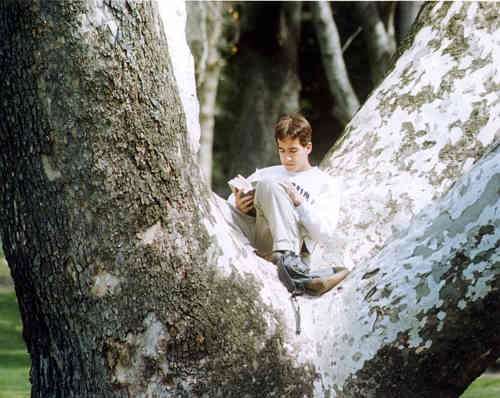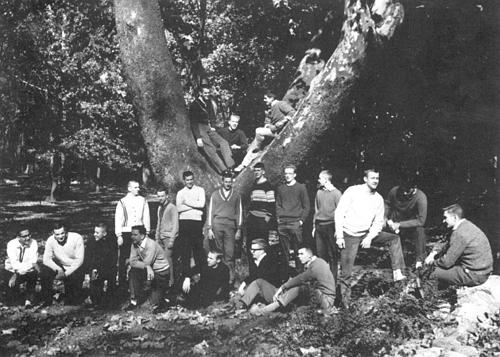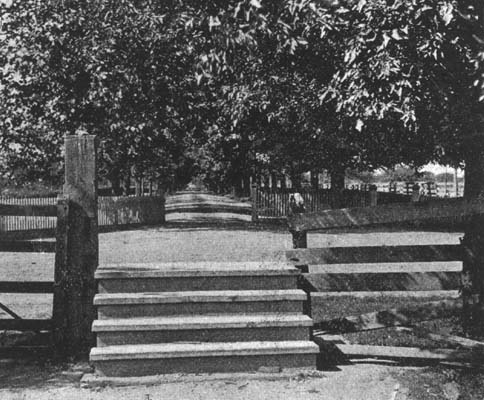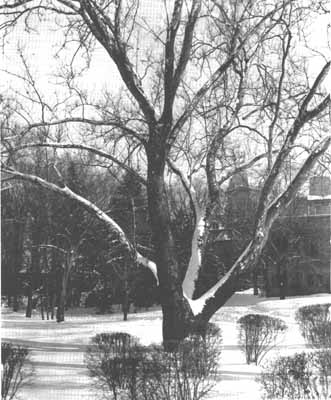
A Cave of Candles / by Dorothy V. Corson

Chapter 20

The Landmark Sycamore -- Guardian of the Grotto
Having disproven the prophecy, "that the lakes every year would take their toll of one human life, (of the 22 deaths in the lakes in 153 years half were townspeople), now I began to wonder if the Legend of the Sycamore Tree was real or just a contrived story created to add to the campus lore. Like the supposed curse, was it just a figment of someone's imagination, fabricated, to spice up a newspaper article, or was there at least a kernel of truth in the legend?
The first time I heard the story in a conversation with Father John J. Cavanaugh, I remember him asking me if I had ever noticed the odd-shaped sycamore that stood in back of Corby Hall. I had to admit I hadn't. I can't imagine, now, how I could have missed it. When I shook my head, he related the story to me. He said it was known as the Vengeance Tree, but was also called by those dubious of the tale, the Superstition Tree. He described it as being in the shape of an open hand pleading for mercy.
Father Cavanaugh was a great story teller and these two, the Missing Empress Eugenie Crown and the Vengeance Tree, were such great stories I've never forgotten them. Although I never thought of them as anything more than tall tales about the campus, they were stored away in my memory as souvenirs of our interlude of conversational friendship. At the time, I attributed both of them to his genial Irish wit, fireside stories a beloved grandfather might spin to amuse his grandchildren.
I could not have known that fifteen years later these two stories from the past would imprint upon the present. As with the "Crown" story, I felt I owed it to Father Cavanaugh to check this one out, too, to see if I could verify it. Most especially, because it was another tradition and it was on the Grotto lawn, a witness to all the history that had transpired there.
Another campus friend, Brother Vitus Schwartz, going on 99 and retired at Dujarie House on the Holy Cross College campus, seemed a likely first source to contact. He came to Notre Dame in 1909. He is still mentally alert and being the oldest religious on campus made him the perfect person to contact. I read the story to him and asked him if he'd ever heard of it before.
He said that as Brothers on campus, in those days, they were pretty much confined to Columba Hall on the "island" and saw very little of the campus. He hadn't heard that story, but in his day he had heard the huge sycamore often referred to on student tours as the Treaty Tree where the Indians supposedly signed a treaty with the white man.
He described in detail the footbridge near the Grotto, and the fish he saw swimming under it as he crossed it. That reminded him of other memories of years gone by and one in particular caught my attention. He said this incident happened in 1917 the year before he left campus for a brief time. He was walking along the bank of St. Joseph Lake and noticed two men in a boat between the small island near Columba Hall and the shoreline, "near where the steam pipe is in the lake," he told me. He said he stopped to chat with them and they told him they'd been given a bag of old relics and told to dump them in the water at the west end of the lake. Apparently, these workmen preferred to put them in some marked place so they would be able to find them later and so, instead, they chose the narrow space between the island and the shore.
Brother Vitus said he had no reason to doubt them and had always wondered about it and what might have been in that bag. He told me he returned to the campus a year later, and many times afterward, having later heard of the missing crown, was tempted to explore that spot for it. Then he smiled and said, "but I had too many scruples to try it." His memory of the missing crown was more evidence of the validity of the story from yet another source.
He described the area in such accurate detail that one could not doubt his story. It was also in 1917 that the Bishops Museum, with its many relics, was moved to various parts of the campus. One could only wonder if there might not have been a place for all the items and those they had no use for or were damaged wound up in the lake. I had read in more than one source that religious items that had lost their usefulness or were to be replaced, by tradition must be disposed of by burying, burning or submerging in water. Many have speculated that it is hard telling what might be found at the bottom of the lakes. I joined Brother Vitus in wondering if his remembrance might very well have been evidence of this practice.
His story brought to mind another one about the lake I found thumbing through an old 1941 Scholastic:
For 95 years the instruments of Notre Dame's first band have rested on the muddy bottom of St. Mary's Lake. There they went on a sunny day in 1846 the year the N. D. U. cornet band was formed. It happened when the organization undertook a concert on the waters of St. Mary's Lake . . . . Suddenly the spectators on the shore saw the raft lurch, saw the close side rear up and musicians, band leader and instruments tip into the lake. Down through the green water swirled silver cornets, bass horns and tuba, leaving only a short-lived trail of bursting bubbles to mark the burial.(219)
With Brother Vitus's bag of relics, the cornet band instruments, the remains of the Empress Eugenie crown, and The Pinta racing galley, hard telling what an underwater metal detector might locate at the bottom of the lakes.
About the huge sycamore tree, Brother Vitus said he had no other recollections except that it had been an impressive landmark on the campus for as long as he could remember and probably dated back to the founding of the University. Brother Vitus Schwartz died, October 21, 1993, while I was editing this portion of the Grotto story.
With its size, it looked to be seven feet through the trunk, it had to be a very old tree. I wondered if it was old enough to have been there even during Indian times. It occurred to me that it might be an interesting experiment to ask an expert on trees the approximate age of the old sycamore. Not knowing how to go about it, I asked Wendy Schlereth, the Archivist in charge of the University Archives, if she could suggest the best way to approach it. She, in turn, gave me the name of a botanist on campus, Barbara Hellenthal, who was co-authoring a book on all the trees, bushes and scrubs on campus.
When I talked to her she was most helpful in suggesting the best way to go about it. She said she knew very little about its background. However, she had run across, by chance, a brief mention of an old Indian legend when she was doing her own research. She said it was all she had but it would have to do because the deadline on the book was just two weeks away. I told her of my plan to investigate ways to age the tree as a means of proving or disproving the legend. She encouraged me in my efforts and said that though the information would be too late for her use, she would be most interested to know what I found out about it.
Taking a core sample, to me, was out of the question. It was too old and too special a tree to take any risk in harming it and she agreed. She then suggested that I call the Purdue Extension at the County-City Building and ask if there might be another way to age it. I called them the next day and was told if I could get the measurement of the tree trunk about shoulder high and its approximate height they would send this information to Purdue and see what they might be able to come up with. Measuring the trunk of the tree was no problem, I told him, but I'd have no idea how to estimate its height. An engineer, he said, would be able to do it. Easy for him, I thought, but not easy for me. I didn't know any engineers, or so I thought.
It was my good fortune that our son, a computer software engineer, was coming home from Chicago that weekend for Father's Day. It suddenly dawned on me, he just might be able to help me.
When he arrived I asked him. "Sure," he said, "there's nothing to it" and he began to explain how to go about it. Not being mechanically minded and thinking I might not be able to remember his instructions, I asked him if he'd mind helping me with both measurements. He readily agreed and that very afternoon found us on campus with a 50' tape measure, an aviator's plotter he had as a teenager, and a plumb made from a piece of string and a pocket knife.
The tree measured an astounding 20 feet 4 inches around, making its diameter about 6.7 feet. He sighted the tallest part of the tree and we paced off the distance at between 70 and 90 feet which determined the general height of the tree. It was an approximate measure, he said, which might make aging it difficult, because this particular sycamore did not have the usual straight main tree trunk. He took pictures of it for me to send with the measurements and suggested any early pictures I might be able to find of it might be helpful to Purdue in assessing its age.

A Lucky Find . . .
After he left that weekend, I found myself again pouring over The Dome yearbooks. This time searching for early pictures of the Legendary Sycamore. The first one I found was in a 1912 Dome. A close-up view of what appeared to be the trunk of the tree but only half of it. I made a copy of it and continued on, paging through each yearbook. I found no other pictures until 1926, when to my surprise, I found a small but very good picture of the tree illustrating a two-page story entitled "The Legend Of The Sycamore Tree!" Someone, there was no author noted, had done a masterful job of documenting the legend, a much longer and more complete version than the first one I'd found in the Scholastic index for 1934. It also had a decorative border around it. This one was not indexed and undoubtedly its existence would never have been discovered had I not been diligently paging through The Domes a page at a time.
Having found a treasure I hadn't anticipated, I tackled the next decade with renewed interest looking for more pictures of the tree to gage its growth, and hoping, as well, to find class pictures taken in front of it. In looking in the 50s yearbooks, earlier, for pictures of the Grotto showing the black stones, several such pictures caught my eye. I never realized at the time they would be on my agenda later on. Not wanting to miss any earlier ones, I made up my mind to wade through every issue from the first to the last, with plans to send the best pictures I found to Purdue. I hoped that a copy of the earliest, the latest, and one in between, might help with their age assessment.
No pictures turned up during a 20 year span from 1926 until 1947. I was paging through the l948 issue,(220) planning to call it a day, when to my delight I found a beautiful full page wintertime photograph of the sycamore with all five limbs intact (one limb is now missing, lost in a storm). Below the snowy picture was the title, "Winter", and these lovely thoughts: "Like ghosts of birds, the flocking flakes / Amid the leafless branches fly . . . "
The previous story, and now this great picture, energized my search and I returned the next day hopeful that I would soon find my first class picture taken in front of the legendary tree. It didn't take long, another decade and I found it, in the 1959 Dome. Shortly afterward, I found another in the 1961 Dome. The dress code had obviously changed in that short time. In 1959 all the students were smartly dressed in suits and ties. By 1961, all were attired in casual collegiate sweaters and slacks. My curiosity aroused, I wondered what more I might I find concerning the tree and the legend, between then and now. I found no other pictures until I got to the last 1993 The Dome. This one was in color but just of the trunk itself. Two students, one a coed -- in T shirts and shorts -- were lounging in the tree using the base of its massive branches like a hammock.
I gathered together the few pictures I was able to find, made copies of them, and dropped them off at the local Purdue Extension headquarters in the County-City Building. They would then mail them to Dr. Harvey Holt, Professor of Forestry, at Purdue University for his assessment.

Another Welcome Breakthrough
About this same time, I found an article in a Scholastic I was sure alluded to the same tree. It became yet another item of special interest associated with it. I intended to use it as a benchmark once I received information on its age. I had run across it months before but its significance hadn't registered on me at the time. It was written by the author of the article that had put me on the trail of new evidence of Sorin's Grotto -- the one signed with the same initials as mine, D.V.C.
I was curious about this author and the name behind those initials, at the time, and decided to look into it. To my surprise, I discovered he had written four other articles about special places on campus during that same school year. A check of the editor's page revealed his name was Daniel Vincent Casey. I read all his other articles with interest, but this one especially, caught my eye. It was the fifth article in a series called "Silhouettes and Sketches" and was entitled, "The Walk To The Stile." It detailed, in eloquent prose, "The Stile" (an arrangement of steps for getting over a fence or wall, while forming a barrier to the passage of sheep or cattle) and the walk which led to St. Mary's Academy. He described it this way:
. . . and before you the picturesque lines of the Stile grow clearer -- the rough boards and rougher carpentry, the rickety gate and the wind-tormented hedgetree guarding it.
The Stile is pictured in the article from the Notre Dame side of the old Niles road, which later became U.S. 31. Across from it can be seen the entrance to St. Mary's Academy. Tucked into this charming article, was a reference that immediately drew my attention:
A light foot-bridge spanned the tideless strait that lay between the College and the House of the Professed, when the walk to the Stile was a delight yet unimagined. The very road that skirts the base of 'the Island' cost three weary summers of an old man's life -- a gentle religious who, after his superiors had given him surcease of labor, took up the work of his own accord, and rested not until it was finished. And you may cover the four hundred yards of it in as many minutes as the years spent in the building.
He speaks of the ancient level of the lake:
Forty years ago, when that splendid old sycamore yonder was a hill-side weakling, all this basin was under water, and St. Vincent's was, in very truth 'the Island.(221)

The article was written in 1896. The splendid old sycamore had to be the legendary one I was researching. And if that were so, then 40 years ago would have been 1856. A "hill-side weakling," as compared to "that splendid old sycamore yonder" could have been up to fifty years old at the time, placing its age somewhere near the late 1700s or early 1800s. I decided to let this important piece of information steep a bit while I awaited confirmation from the Purdue Extension regarding the age of the tree.